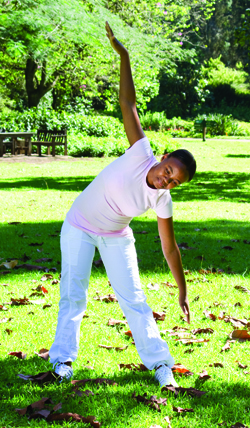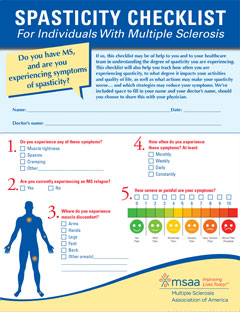Spasticity (stiffness)

Spasticity is a common symptom in multiple sclerosis. It is a tightness or stiffness of the muscles, which typically occurs in the legs (calf or thigh), groin, and buttocks. Mild spasticity may not be painful and can sometimes offer extra support when standing; however, more severe spasticity may cause significant discomfort if not treated.
Spasticity in multiple sclerosis is a result of demyelination along the nerves of the brain and spinal cord that control movement. Treatments include exercise and stretching, complementary and alternative medicine (CAM) therapies, aquatic therapy, braces and other devices, as well as medications.
In addition to the physical effects of spasticity, this symptom can also affect one’s quality of life and emotional health. Significant spasticity can have an effect on relationships, employment, and other activities, and can often be accompanied by anxiety, depression, and low self-esteem. Seeking help through one’s medical team and taking advantage of the different treatments available can help to minimize the effects of spasticity in multiple sclerosis.
Causes and Effects
Spasticity is a common symptom in multiple sclerosis. It is a tightness or stiffness of the muscles – occurring typically in the legs (calf or thigh), groin, and buttocks. Although less common, some individuals may experience spasticity in their back. These are all muscles that help people to stand and balance in an upright position.
Spasticity in multiple sclerosis is a result of demyelination along the nerves of the brain and spinal cord that control movement. Sometimes the stiffness caused by spasticity is slight and can actually be helpful by giving individuals more support to stand or turn. Mild spasticity is not painful. However, when spasticity is more severe, it can become painful. More energy is needed to perform daily activities when spasticity is more pronounced, causing discomfort and limiting movement.
Treatment Strategies
Through different treatment strategies, spasticity can be managed. And when one’s spasticity is reduced, this in turn allows the individual to be more comfortable, stronger, and to move more freely. Fatigue is also reduced, as movements do not require as much effort. Coordination improves as well, because muscles are working together more efficiently.
Several strategies may be used to reduce the effects of spasticity. Initially, any other treatable issues that may contribute to this symptom should be addressed. For instance, if an individual is experiencing pain separate from spasticity – perhaps from an infection or a skin sore – these can worsen muscle tightness. Treating these types of underlying conditions can help to reduce spasticity.
Exercise and Stretching
The next step for many individuals in treating spasticity is to consult a physical therapist to help create an exercise plan, one which uses different stretching exercises that can be done at home. In the 5th edition of Managing the Symptoms of Multiple Sclerosis, examples of helpful exercises are described, as follows:
“A thorough stretching program includes a series of exercises that are performed in certain sitting or lying positions that allow gravity to aid in stretching specific muscles. While in the sitting position, a towel or long belt may be used to pull on the forefoot and ankle to stretch the calf, or to stretch the thigh muscles when one is lying on the stomach. Certain muscles may be relaxed more effectively while one is lying on the stomach or side, or while lying on all fours over an exercise ball, rocking rhythmically forward and backward.
“The simplest and often the most effective way to reduce spasticity is passive stretching, in which each affected joint is slowly moved into a position that stretches the spastic muscles. After each muscle reaches its stretched position, it is held there for approximately a minute to allow it to slowly relax and release the undesired tension. This stretching program begins at the ankle to stretch the calf muscle, then proceeds upward to the muscles in the back of the thigh, the buttocks, the groin, and, after turning from the back to the stomach, the muscles on the front of the thigh.
“Range-of-motion exercises differ from stretching exercises in that the movement about the joint is not held for any specific length of time. Although range of motion is important, holding the stretch is significant, and patience is essential when doing the stretches.”
According to the book, the key to managing spasticity is to continually increase the number as well as the type of movements used in these exercises. However, care must be taken to use the least amount of effort possible while performing these exercises, so as to not overuse any muscle groups or cause fatigue.
CAM and Aquatic Therapies
Another strategy is to use complementary and alternative medicine (CAM) therapies, such as relaxation techniques, deep breathing, and guided imagery. The relaxation techniques involve the progressive tensing and then releasing of different muscles, along with deep breathing and guided imagery. Some individuals may also benefit from acupuncture. In addition, using cooling devices or ice packs after exercise may help to reduce spasticity.
One very helpful method of reducing spasticity is aquatic therapy or aquatic exercise (both refer to forms of exercise in a swimming pool). The natural buoyancy from activity in the water enables participants to move with less effort. Both stretching exercises and range-of-motion exercise may be performed in a pool.
Please note that the temperature of the water in the pool is very important for individuals with MS. If too cold, it can cause spasticity to worsen. If too warm, individuals may become fatigued. Experts have determined that 85 degrees is about the ideal temperature for people with multiple sclerosis.
The medical use of cannabis (marijuana) is controversial since it has not been legalized nationally, but certain states have legalized its use by prescription through approved distribution centers. Studies with MS patients and cannabis for symptom relief are limited and the results have been mixed. With MS, in addition to the symptoms of pain and insomnia, cannabis may be used to reduce the severity of spasticity. Some individuals have experienced positive effects from cannabis on their spasticity.
Devices
Beyond the treatment of underlying conditions, and an exercise plan that includes stretching, range-of-motion, and possibly aquatic exercise, certain devices may be of great assistance. These can be particularly helpful in avoiding contractures (causing reduced movement in a joint) by allowing muscles to relax while maintaining a proper position.
Examples include toe and finger spreaders as well as braces for the foot, hand, or wrist. These devices are referred to as orthoses and may be custom-made by an orthotist for an optimal fit. Many people are familiar with an ankle-foot orthosis (AFO), which holds and angles the foot and ankle in the best position for maximum comfort and mobility. It can also relieve stress on the knee.
Medications
Other medications are also available and may be more appropriate for some. These decisions can only be made through consultation with one’s healthcare provider. Different therapies may also be used in severe cases that do not improve with the traditional treatments. These include procedures that temporarily block the nerve and muscle (Botox® or Myobloc™ injection), among other, more permanent treatments. Examples include chemically inactivating a muscle and surgically cutting specific nerves or tendons.
The following medications may be used to treat spasticity:
- Baclofen (formerly available as Lioresal®)
- Gablofen® (baclofen injection)
- Zanaflex® tablets and capsules (tizanidine)
- Clonidine
- Valium® (diazepam)
- Klonopin® (clonazepam)
- Dantrium® (dantrolene sodium)
- Neurontin® (gabapentin)
- Tegretol® (carbamazepine)
- Keppra® (levetiracetam)
- Lyrica® (pregabalin)
- Intrathecal baclofen pump
- Botox®, Dysport®, and Myobloc® (botulinum toxin) injection
Impact on Quality of Life
Results of a study in the United Kingdom were published in the article, “Spasticity in multiple sclerosis: Associations with impairments and overall quality of life” (by K Milinis, et al., published in Multiple Sclerosis and Related Disorders). Of the 701 study participants with clinically definite multiple sclerosis, 85.4 percent (599) reported some degree of spasticity. The study found that in the presence of other variables such as fatigue, anxiety, and limitations in activities, spasticity retained a significant, direct relationship to an individual’s quality of life (QOL). As one’s spasticity becomes more severe, his or her overall QOL is also significantly worsened.
The study found that spasticity can have negative effects on an individual’s psychological health and social roles. Relationships, employment, and planning for the future may be affected, and participants reported that anxiety, depression, low self-esteem, and locus of control (the belief in one’s ability to control the events in his or her life) are all affected by spasticity as well. In addition to depression, high correlations were found between spasticity and fatigue, pain, and bladder dysfunction.
The reduced ability to work and the burden on a care partner are significant contributors to financial costs related to spasticity. While additional studies are needed to better understand the full impact of spasticity on individuals with multiple sclerosis, the authors of this study emphasize the importance of early and continued treatment of spasticity, to maximize mobility and prevent the loss of productivity.
References
Schapiro, RT, Managing the Symptoms of Multiple Sclerosis, 5th edition, (Demos Medical Publishing, 2007).
K Milinis, et al., “Spasticity in multiple sclerosis: Associations with impairments and overall quality of life.” Multiple Sclerosis and Related Disorders 5 [2016] 34-39.
Updated in December 2023 by Dr. Barry Hendin, MSAA Chief Medical Officer
Original content reviewed by Randall T. Schapiro, MD

